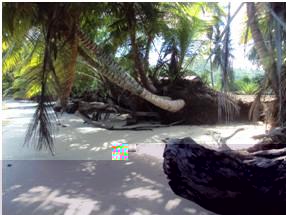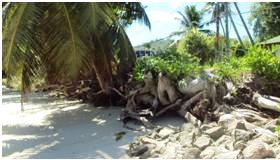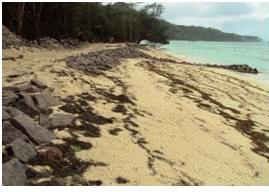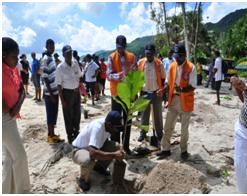Mitigating human and climate change challenges on coastlines |16 June 2012
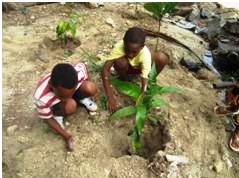

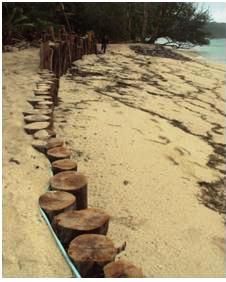
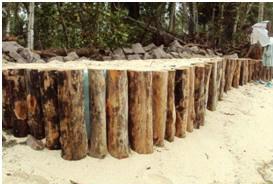
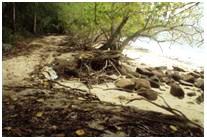
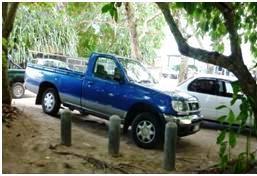
The close interconnection and interaction between the highland and low land given the steep characteristics of the highland dropping immediately onto the coastal land brings out this aspect of integrated management clearly. Given this consideration of the Seychelles being entirely coastal, coastal zone management is considered an important element of environment management.
As envisaged by the Intergovernmental Panel on Climate Change (IPCC) reports for the coastal zone and human settlements, a rise in sea level will particularly affect tourism and fisheries which are the pillars of our economy. Important to note is that about 85% – and growing – of the human settlement and infrastructure in Seychelles are located along the coast.
This figure shows the vulnerability of Seychelles to effects of climate change which are highly manifested along the coast.
Sea level rise threatens livelihoods of coastal inhabitants and may cause eventual displacement of large proportion of our population. Coastline recession through the effects of sea level rise as well as increased erosion as a result of increased frequency and intensity of storm surges – which are being seen to happen – is inevitable. For such reasons this places Seychelles at the risk of the effects of climate change and hence much should be done to put in place measures to adapt, build resilience and minimise our vulnerability to the impacts of climate change.
The latter is in fact one of the key strategic priority objectives being targeted in the Seychelles National Climate Change Strategy and hence shows the great importance that needs to be taken in regard to our coastal zones. Measures of adaptation and resilience of coastal zones to the effects of climate change are highly based on the ground approaches and these include use of soft and hard measures for securing our coastlines from impacts such as surges through spring tides, tsunamis – which are on an increase, coral bleaching, erosion etc. The implementation of these measures to safeguard our coastlines however have proved to be costly given the hard components often involved such as rocks and timber for armouring or timber pilling just to highlight the main techniques currently being used for coastal defense and rehabilitation.
However several other soft components are also vital for a healthy coastal front including healthy beach fringe vegetation. Therefore there is a constant need to prevent human impacts such as trampling both human and vehicular from destroying the beach fringe. This is currently being controlled by the use of large rocks or concrete bollards that are placed on the back dune to prevent vehicular access to the dunes. Both rocks and concrete bollards are costly components and there are several locations old and new that have been identified across Mahe and the inner islands as necessary to be blocked off from vehicular access. Many locations have already been damaged significantly with high vegetation loss. There is a need also to re-vegetate such locations in a bid to enhance the beach fringe ecosystem, an important component in erosion control.
Due to the intensity of erosion by both natural factors and human induced factors, survival of the many coastal flora and fauna are vital for stabilising the beachfront. Beach fringe plant species are mostly bushes and small trees in character such as vouloutye.
Their many low branches and extensive root systems are important component in stabilisation as they decompose and become a part of the soil increasing cohesiveness, as well as adding essential nutrients to the soil necessary for plant growth. The creeping plants like patatran on the other hand spread over the soil securing more space for other species to grow and thus help form new land. The branches on the other hand are crucial in enabling the plants to withstand the strong winds which are usually more predominant along the coast than further inland. Further to that the leaves and branches reduce the shifting of dry sand by wind to the back dune by trapping blown sand. Therefore as can be deduced the entire system functions in such a way as to maintain an input of sand which is important for absorbing wave power hence limit erosion.
Erosion proving destructive
Erosion across the islands of the Seychelles is proving to be more active and more destructive over time. Many beaches are losing their pristine character, many of which have been well frequented by both locals and tourists including the Anse à la Mouche and Anse Gaulette beaches as examples. In many areas beaches have receded to distances of up to 40 metres such as at Anse Kerlan on Praslin where property owners are losing much valued land right before their eyes. This shows there is great concern for the faith of our beaches – which undoubtedly is one of our biggest attractions – in terms of tourism products. Nature is not selective when it comes to coastal erosion. The increased effects of climate change highly manifested through increased frequency and intensity of storm surges, rise in sea temperatures – which cause coral bleaching, reducing reef vigour to dissipate wave energy approaching shoreline – as well as sea level rise makes no exception when striking the coastlines.
Even the world’s most beautiful beaches are scoured by erosion such as is the typical case of Anse Lazio which is losing much of its sand, large Takamaka trees being denuded and the beach obviously retreating inwards. As such we are faced with the challenge to manage, protect and conserve our coastal zones in the light of climate change impacts and increased human activity. The mentioned responsibilities have been mandated to the Coastal Zone Management Unit within the Environmental Engineering and Wetlands Section in the environment department. The section headed by acting director Nimhan Senaratne is a key actor in designing coastal protection measures being implemented across the main islands of the Seychelles. Shortcomings of which include lack of manpower handling the unit’s numerous responsibilities which have led for example to the beach monitoring programme to be halted for a couple of years now. This programme – which aims at collecting beach profile data across the main islands of Mahe – is of great importance for understanding the change in beach profile over the years allowing determination of extent of retreat or buildup of a beach, volume of sand loss and trends of sand loss over seasons or over years. From such information, the most appropriate measure can be determined for coastal protection and rehabilitation where need be. Other limitations of the unit include lack of expertise in coastal engineering to render the best coastal practices, conservation and protection measures most suitable to the local context, and lack of necessary coastal engineering tools – and of course know-how on how to handle them – for modeling scenarios in coastal dynamics which often may prove vital in new proposed coastal developments such as marina. Regardless of such constraints the dedicated staff strive to advocate of best coastal practices as well as of impacts of climate change through education – such as having presentations at school – involving schools and key stakeholders such as community, youth council, hotels, non-governmental organisations and partners such as the Lions Club of Paradise in coastal activities such as replanting, wetland restoration and maintenance just to highlight a couple.
Moreover the unit continuously tries to come up with innovative methods for securing the coastlines from further effects of erosion such as integrating soft and hard engineering techniques in the likes of rock beaching or timber piling – two main measures being used presently – coupled with revegetation. Beaching as opposed to armoring incorporates the slanting of angle of rocks placed along the coastline in a gentle enough angle of repose to allow for maximum dissipation of wave energy on approach to coastline at the same time allow for sand deposition over the rocks.
Such method allows not only protection of the immediate area behind but attempts to re create lost beach. A typical example of such work has been implemented at Petite Anse Marie Louise at Takamaka whereby a stretch of 111 metres of coastline was being scoured through by strong waves. This stretch which also served as the sole access road for a number of families residing the upper part of Petite Anse Marie Louise was unable to allow for the passing of vehicles to these homes, which during the water shortage period last year meant Public Utilities Corporation bowser trucks could not deliver water to the homes. The residents had to walk to and from the hill to get water for their daily use. The environmental engineering and wetlands section responded to concerns brought out by the district administration and the residents themselves by implementing a rock beaching project which was polished up by revegetation by Takamaka students, Seychelles National Youth Council, Lions Club of Paradise Seychelles and the Environment Department. The project has so far proved highly effective as the road had been restored and enlarged through backfilling and the beach is re-forming due to deposition of sand over the rock beaching.
Anse à la Mouche beach rehabilitated
Another key project being undertaken – since November last year– is the rehabilitation of the Anse à la Mouche beach strongly instigated by President James Michel and Minister Joel Morgan, the then Minister for Home Affairs, Environment, Transport and Energy. This project mainly constitute of rehabilitating 178 metres of severely eroded coastline by the use of backfilling with coral fill to recreate duneland, timber piling to protect inland from incoming waves and trap onshore sand transport as well as revegetation to stabilise the newly created duneland.
This project has encountered delays in implementation highly due to the difficulty for acquisition of raw material – mainly timber and coral fill – tidal problems (only few hours daily can be productive given high tides and high water table), however on a positive side the residents nearby have been greatly involved through involvement be it in advising, daily visits to see works done, offering of plants and rocks for implementing the project. Special mention here goes to Mr Keith of Anchor Café and Mrs Janker of Blue Lagoon.
Upon completion of backfilling, the section intends to work closely with these stakeholders as well as the Seychelles Agricultural and Horticultural Training Centre to implement a landscaping plan for the area which is aimed at providing a recreational yet protective buffer area for the Anse à la Mouche coastal front. Projects are not limited to these. The section has also recently implemented the rock armouring works at Mare Anglaise which suffered intensively during the events of high tide and strong waves of early week of March.
A number of projects are also projected to be implemented this year including that of North East Point and La Passe, La Digue – to be pilot project of the Japanese International Corporation Agency presently undertaking coastal erosion study in Seychelles – and some other small projects to be implemented by the section.
Important to mention is that the section often depends greatly on key partners for the successful implementation of coastal projects -- from the contractors delivering the works to the government bodies facilitating formalities such as Ministry of Finance, Procurement Oversight Unit as well as Tender Board for understanding the dynamism of coastal environments in order to assist in approval of project and their smooth implementation.
The department would therefore like to take this opportunity to thank all the key partners and call upon all members of the public to acknowledge the effort being put into the protection and conservation of our coastlines in the face of human pressure and climate change. The regulations set out to control development on the coastal strip and projects aiming at coastal protection are strongly focused towards safeguarding people’s livelihoods by securing the coastlines.
Contributed by the Ministry of Environment and Energy






